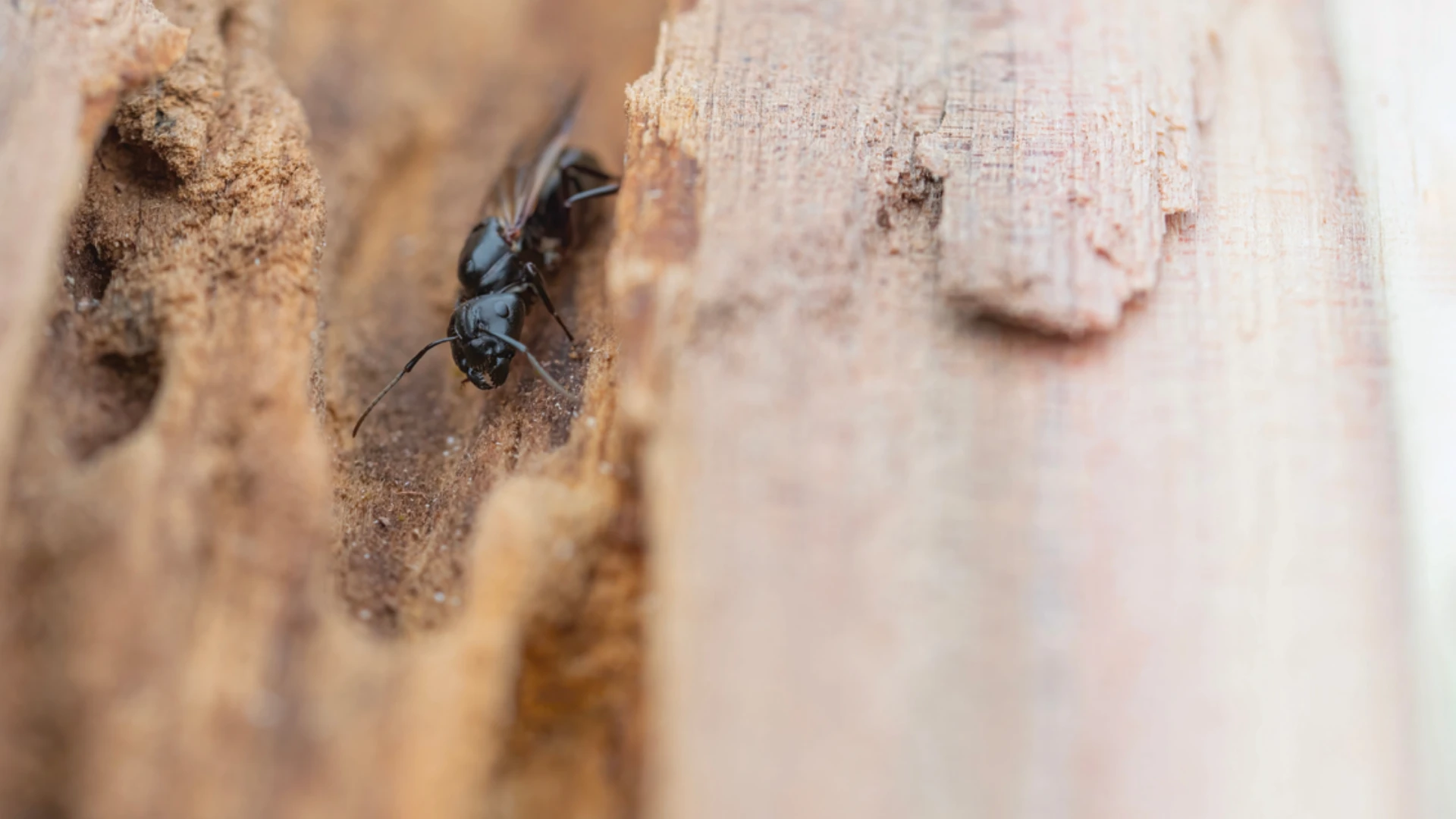
 When mice and rats occur inside our buildings, the assumption made by most is that the rodents came in through some “open door.” But relative to city rodents, what is “open”? Because based on their behavior alone, rodents most times do not enter through doors that have been left open. Rather, they enter in through “closed doors” containing “threshold gaps” of different types and sizes (including gaps created by the gnawing of the rodents themselves).
When mice and rats occur inside our buildings, the assumption made by most is that the rodents came in through some “open door.” But relative to city rodents, what is “open”? Because based on their behavior alone, rodents most times do not enter through doors that have been left open. Rather, they enter in through “closed doors” containing “threshold gaps” of different types and sizes (including gaps created by the gnawing of the rodents themselves).
This article takes a keen observational approach to the relationship between urban rodents and the everyday doors of our residential and commercial buildings. For example, what attracts rodents to doors? How are rodents specially equipped for gaining entry beneath and between doors? Which door models are most vulnerable to rodent entry? And how can we as pest professionals offer the best rodent-proofing services, materials and/or education to clients and communities to protect homes, foods and overall community health? Let’s take a look.
Exploration of Gaps and Holes.
Mice and rats are compulsive explorers. They are always on the go. They may be driven by hunger, thirst or the need for better or alternative shelters. But sometimes, like humans and other mammals, they explore just for the sake of exploring (right now as I write this, we are anxiously awaiting our first satellite close-up photos of Pluto!).
Some buildings can be under constant rodent pressure from exploring rodents, especially if natural harborages such as open fields, woods, waterways and the like are nearby. And consider that from beneath gappy door thresholds, buildings leak warm air currents (e.g., during the chilly nights of autumn) and all types of food odors year-round. And once the first rodent has squeezed beneath a threshold gap, it may leave rodent scent for future exploring rodents to follow in the same path. So rodent entry begets rodent entry.
Human buildings are ideal substitutes for the natural shelters of rodents in the wild. Consider how a building can resemble a hollow log to a mouse or rat. Or how a delivery door offers shelter into “the log” that has been absorbing the warm rays of the sun all day long and is leaking that stored heat all night. Or how various cable and electrical lines are much the same as the climbing vines of a tree leading to a tree crotch containing the smell of acorns or other seeds.
 As part of these natural explorations and those along building foundations, rodents are constantly and incessantly shoving their elongated, pointed muzzles (Figure 1) into various holes, nooks, crannies and crevices they encounter. Once their muzzle is inserted, they can feel and smell whether or not further exploration of the crevice or gap is apt to be rewarding. Some of their specialized facial whiskers help them determine if they can fit into a hole, or if they need to expand the opening by gnawing with their powerful incisors.
As part of these natural explorations and those along building foundations, rodents are constantly and incessantly shoving their elongated, pointed muzzles (Figure 1) into various holes, nooks, crannies and crevices they encounter. Once their muzzle is inserted, they can feel and smell whether or not further exploration of the crevice or gap is apt to be rewarding. Some of their specialized facial whiskers help them determine if they can fit into a hole, or if they need to expand the opening by gnawing with their powerful incisors.
What’s more, mice and rats are exceptional gymnasts. They climb, jump, leap, squeeze, contort, run, hang, crawl and swing while they travel along trees, branches, vines and rock crevices. This occurs in urban areas and structures as well. In most cases, if a mouse or rat can fit its head beneath a crevice or into a hole, its backbone and the rest of the body is flexible enough to follow. (However, it’s a myth that rodents can “flatten out” their bodies due to soft cartilage or special joints.)
Finally, it’s important for the discussion that follows to note that exploring rodents do as most mammals do. That is, they select the paths of least resistance. A threshold gap beneath a door of a building is the same as a hole in a hollow log at just the right spot. Not much further work is needed to exploit the resource.
Doors 101.
The world of doors is enormous. There are hundreds of models of doors and as many variations on the models depending upon the applications needed. If you Google “doors,” you’ll quickly get the picture. However, the most common doors of homes and commercial structures fit into only a few types. For the purposes of this article, and for our discussion on rodent proofing, we will focus on three broad types:
 1. Single-swing doors (e.g., main entry doors of homes, small restaurants, apartments, main doors of commercial facilities, etc.). (See Figure 2.)
1. Single-swing doors (e.g., main entry doors of homes, small restaurants, apartments, main doors of commercial facilities, etc.). (See Figure 2.)
2. Double-swing doors (two doors that meet in the middle [e.g., glass doors of shopping malls, high-end office buildings, larger restaurants, main entrances to schools, etc.]) (See photo top of page.)
3. Overhead roll-down doors (e.g., garages, warehouses, supermarket delivery doors).
Door Terms.
If you read door literature from different building-code organizations or door manufactures, the terminology of doors can be confusing. In some cases, terms are used interchangeably while in others, terms have specific uses within a particular text, code book or manufacturer. In short, with door terminology, it truly is a matter of semantics as to who is speaking, as well as perhaps each person’s door “history.”
For example, the terms “door sill” and “threshold” are regularly used interchangeably. So too are the terms brushes, bristles, sweeps, strips and seals. Some door “sweeps” have no brushes; some brushes sweep across the floor. Some “strips” claim to keep out cold air currents as well as claiming to offer rodent sealing. Like rodent gymnastics, there are human word gymnastics as well.
Semantics aside however, a few terms are important to clarify so as to be able to educate our clients as to what rodent proofing may need to be done.
Threshold: The floor area at the entrance to a room or building when passing through a door. A threshold can have construction elements (plates) made of wood, metal or stone possibly covering a joint that occurs beneath a door bottom.
Door sill: A shelf or slab of stone, wood or metal at the lowest portion of a door assemblage; and/or used to describe the extended plate or shelf for those doors that are higher than the exterior space to which the door leads (similar in design and concept to a window sill). Often associated with a “step-up” style of door entry.
Astragal: A molding, attached to one of a pair of swinging double doors, against which the other door strikes.
Astragal Gap/Space: Loosely refers to the gap that occurs at the threshold area between double doors where the two doors meet. (See photo top of page.)
Saddle: Usually an elevated convex plate of metal or wood installed along the threshold area of a door base. Saddles are often used to cover crevices, expansion joints or to provide a leveling element for uneven floors so that the door bottom evenly meets the threshold surface. When saddles are used, the saddle itself will often be called “the threshold.”
Inspecting Doors.
As mentioned previously, it is a myth that rodents flatten out their bodies and slither beneath any tiny threshold gap. They can’t. But in fairness to those who swear they’ve witnessed this, it actually can appear that a mouse shimmying through a door threshold crack is “flat” when observed from the normal human perspective of looking down from a distance of 5 or 6 feet up.
Still, it is not difficult (for anyone) to inspect a door to determine if a threshold gap will allow a rodent entry. But it cannot be done while standing up. Crevices should be measured. The house mouse requires a crevice opening of only ¼-inch (6 mm) high. If it is attempting to get through a hole, it requires a width of 3/8-inch. The larger rat (including a young rat) requires crevices of at least ½ inch (12mm) in height and holes of ¾-inch wide.
Certainly, a ruler (or other measuring device) can assist in determining if a rodent can gain entry (e.g., if you can roll a No. 2 standard yellow pencil beneath a door, that is sufficient for a mouse; a dime for a mouse hole; a quarter for a rat hole).
One of the fastest ways to determine a door’s rodent vulnerability is to simply stand on the inside of a closed door with the lights out and look outward to check for any exterior light leaks. As a general rule, any light noticed at any part of the threshold and/or door corners is sufficient to require a ruler measurement if not immediate repairs.
A final but important note on door inspections is to keep in mind that if the door materials at the thresholds and jamb corners contain “soft” materials, such as wood, vinyl strips or plastic bristles, rodents need only an edge of just 1 or 2 millimeters. Such tiny openings serve an exploring rodent as “gnaw-starts” for its incisors to enlarge the hole size to permit entry.
Rodent Proofing Doors.
Needless to say, the best rodent-proofed door is one in which the thresholds and jambs are built correctly (i.e., tight) from the get-go and are maintained over time. When this is done, supplemental rodent-proofing materials usually are unnecessary. Unfortunately, this is often not the case. A large percentage of everyday doors remains relatively open to mice (and many to rats as well). Even a quick walk about your own neighborhood from the sidewalk perspective is likely to provide you with a fast confirmation.
The good news is that rodent-proofing is typically not overly difficult, complicated or expensive. Nor does most proofing require massive construction or elaborate tools. (Plainly, for complicated doors and/or operations, a door contractor or an experienced pest exclusionist should be consulted.)
Rodent-proofing Products.
 If you shop for weather-proofing materials (e.g., weather stripping), there is a wide variety of choices in stores and online. For quality pest-proofing materials however, the choices are fewer. And, as mentioned earlier, the terminology of both “weather stripping” or “pest proofing” is a confusing mix of seals, strips, brushes, bristles, barriers and others. For the purposes of this article, two of the most common types of “door sweeps” used by the professional and the public alike are discussed:
If you shop for weather-proofing materials (e.g., weather stripping), there is a wide variety of choices in stores and online. For quality pest-proofing materials however, the choices are fewer. And, as mentioned earlier, the terminology of both “weather stripping” or “pest proofing” is a confusing mix of seals, strips, brushes, bristles, barriers and others. For the purposes of this article, two of the most common types of “door sweeps” used by the professional and the public alike are discussed:
1. Rubber-encased steel fabric sweep (RESF).
2. High-density brushes (HDB).
(Author’s note: The acronyms, REFS for rubber encased stainless steel fabric sweep and HDB for high-density brushes, are used here for brevity, but do not represent any industry standard acronym.)
The rubber-encased steel fabric sweep is designed with a high-weatherability rubber EPDM encasement containing a stainless steel fabric (“mesh”). The steel fabric is compressed and specially laminated to the interior surface of the rubber (Figure 4). Depending on the model, RESF sweeps can rodent-proof threshold gaps upwards of ¾ inch in height.
A RESF sweep presents a formidable challenge to rodents probing around door thresholds both in time and in risk of bodily injury. Essentially, a rodent encounters a nine-layered barricade made up of rubber encasements, screens, adhesives and a 0.70-inch steel fabric mesh (e.g., commercial sweep).
For city mice and rats, an RESF sweep is a lot to “get through.” This is important because, for any prey species of rodent, the longer they remain away from cover, the greater the danger. The RESF sweep also poses a significant amount of bodily harm should the rodent successfully penetrate the first two barricades. Because now it must negotiate hundreds of sharp steel fibers poking from all directions at its eyes, nose, mouth, whiskers, paws and the rest of their body.
High-density Strip Brushes.
 High-density brushes (HDBs) are made from thousands of high-flexibility nylon bristles, densely packed to form a bristle-style barrier at thresholds and other areas of doors of different types (Figure 5).
High-density brushes (HDBs) are made from thousands of high-flexibility nylon bristles, densely packed to form a bristle-style barrier at thresholds and other areas of doors of different types (Figure 5).
The brushes are flexible in both a back-and-forth motion as well as being compressible along the vertical plane. So they conform to both even and uneven surfaces, including those with relatively large threshold gaps up to 4 inches. High-density brush models also can be used to create barriers to the astragal spaces that commonly exist between many double-swing doors.
With high-density brushes, determined rats (rarely mice) can whittle away at each bristle to gain entry. And there is no pain impediment to a rodent clipping at a nylon bristle. But again, to do so among many bristles, the rodent must extend its exposure time.
Examples of RESF and HDB pest-proofing materials (as well as various models) can be found by Googling “door sweeps,” “pest barriers,” etc., or by visiting websites such as www.getxcluder.com, www.sealeze.com, and others.
On-the-job Advice.
Following are some tips and considerations when pest-proofing doors:
1. Use quality materials that are specifically manufactured to rodent proof structures. Weather proofing is not rodent proofing. (But rodent proofing is also weather proofing.)
2. Install/repair with precision: millimeters are important. Leaving small crevices can encourage rodents to squeeze harder or to start gnawing and enlarge the crevice to enable entry.
3. Rodent-proofed doors should be monitored for maintenance needs on a quarterly basis for residences and at least monthly for heavy-use commercial facilities.
4. When considering which brand of rodent-proofing sweeps or brushes to use, analyze each situation:
a. Where exterior rodent pressure is light (e.g., an occasional mouse), or where there is an abundance of human activity on a 24/7 basis (i.e., too much threatening noise during rodent explorations), high-density brushes or rubber-encased steel fabric sweeps can be used.
b. Where rodent pressure is ongoing, or for sensitive facilities where maximum protection is necessary, RESF sweeps offer a high level of deterrent to exploring mice and rats.
c. For irregular thresholds (in low rodent pressure areas) and for relative high threshold gaps, HDBs are the appropriate barriers.
d. For irregular thresholds in areas of high rodent pressure, the threshold should be repaired via saddles or some other means (concrete layering, etc.) followed by the use of a RESF sweep.
e. For astragal gaps large enough for mice, astragal space high-density brushes can be installed.
f. For astragal gaps large enough for rats, door repairs or door supplements should be considered.
Summary.
Without a doubt, the threshold gaps of doors are a primary entry point of rodents to buildings in cities and towns the world over. And rodent entry begets rodent entry. It makes little sense for property owners to repeatedly spend money on interior rodent service if exterior doors are closed to humans but open to rodents. Pest exclusion is not only the most basic approach that should be taken, it is also the most prudent and, thus, the most sensible.
But property owners need to be educated by pest professionals who are trained about the incredible capabilities of mice and rats around doors. It’s not enough to say, “You must fix your doors.” To which the client could respond, “Well you’re the pest expert, tell me specifically what should be done and what should be used.”
Rodent proofing doors requires inspection, situation analysis, selection of the correct materials and attention to detail during the installations.
To a large degree, clients pay us, the pest professionals, because we are trained to see what they overlook. And certainly they overlook the threshold gaps of doors they enter and exit day-in and day-out. But what happens in the quiet of the night when those doors are finally closed and locked? Rodents are using the same doors; no keys required.
About the author: Bobby Corrigan is a private consultant based out of Indiana and New York City who specializes in rodent pest management for a wide variety of commercial situations.

Explore the August 2015 Issue
Check out more from this issue and find your next story to read.
Latest from Pest Control Technology
- Rose Pest Solutions Becomes Official Pest Provider of Chicago Fire FC
- WSPMA Hosts Legislative Day at Washington State Capitol
- A-1 Pest Control Marks 59 years in Business
- Hawaii PCO Shares Regulatory Challenges, Business Impacts from Lahaina Wildfires
- 5 Tips for Reducing Waste in the Office and in the Field
- OvoControl Now Available in Chile
- Envu Announces Savings Programs for Pest Management Professionals
- Follow the Trail





